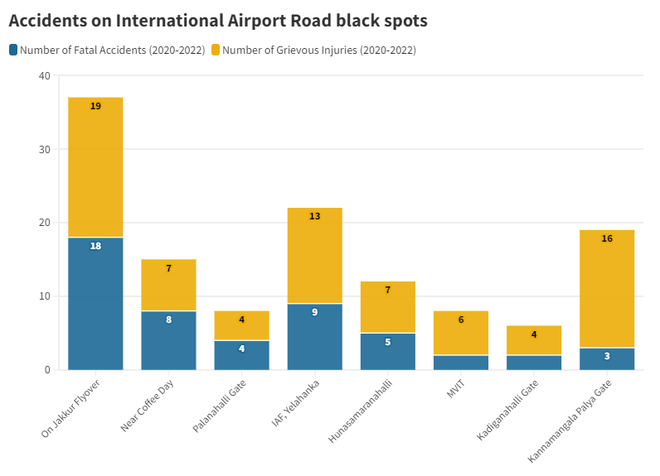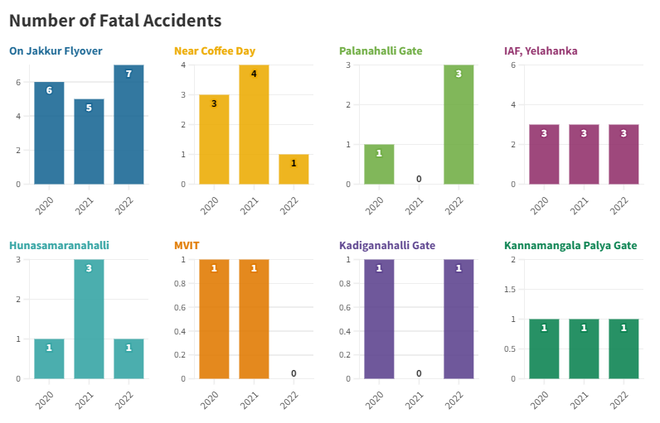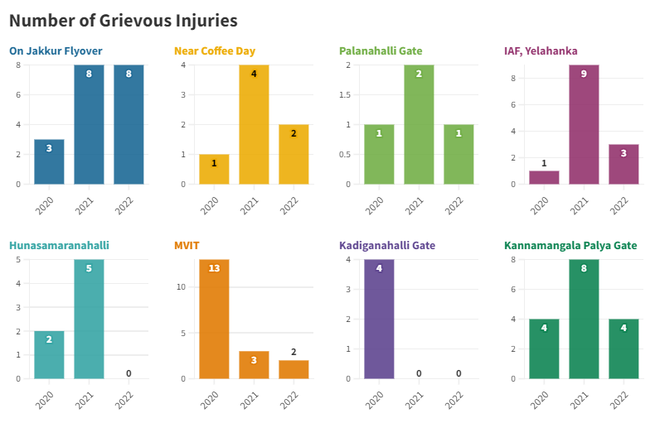It was around 1.50 a.m. of July 3 when N. Suresh, 40, a police constable with the Devanahalli station, who was on night rounds on the elevated expressway to Kempegowda International Airport, saw an SUV parked in the middle of the road after it had met with an accident. As Suresh was checking the SUV, a speeding car from the opposite direction lost control, hit the median, crossed over and collided with the accident-hit SUV, killing Suresh and another passenger in the car. The car had six people on a joyride, and the driver was allegedly drunk and speeding.
The KIA expressway has turned out to be one of the deadliest stretches in the city. Bengaluru City Traffic Police have identified 8 accident black spots on the road, of which Jakkur flyover has emerged as one of the deadliest spots with 27 accidents and 18 fatalities reported during the 2020-22 period.
“Most of the accidents on this stretch occur during night and early morning when the traffic is less and speeding is rampant,” said Sachin Ghorpade, DCP (Traffic-North). While there is confusion even among the traffic police on the maximum speed limit on the expressway, whether it is 80 kmph or 100 kmph, those limits are often violated on the stretch. “In many fatal accidents on the stretch, we find vehicles zooming past at over 120-140 kmph,” said a senior traffic police official.

A risky proposition
Chikkathimmaiah, a farmer who grows greens and vegetables in Devanahalli, drives a mini-van to K.R. Market every morning to sell his produce. He said driving a slow-moving vehicle on the tolled-expressway during morning hours is a nightmare.
N. Ashok Kumar, a cab driver who drives regularly to Kempegowda International Airport during late night and wee hours, said lack of enforcement of speed limit was one of the biggest problems they faced on the stretch. “Most vehicles do not adhere to speed limits on the stretch. As SUVs and even bikes zoom past, many on joy rides, many drivers drunk, especially during weekends, every trip to the airport is a risk. Moreover, in the late night and early morning hours, chances of drivers feeling sleepy and their reflexes being low are also high,” he said.
Being one of the finest highways within the city and the fact that it leads to Nandi Hills, one of the most popular early morning destinations in the city, the stretch is plagued by joyrides both in bikes and high-end cars.
Contactless enforcement
Patrolling the expressway has itself turned fatal. Unlike other highways, there are no highway patrols on this stretch. . “We have decided to go for contactless enforcement on the stretch. That is the only feasible option. We have proposed to put four Intelligent Traffic Management System (ITMS) cameras which will flag speeding vehicles and generate challans. We will also put up digital speed display boards along the highway to act as warning systems for speeding vehicles,” said M. N. Anucheth, Joint Commissioner (Traffic), Bengaluru.
Bengaluru Traffic Police (BTP) have also suggested installing rumble strips at five junctions identified as traffic bottlenecks - Palanahalli Gate, Indian Air Force - Yelahanka junction, Hunasamaranahalli junction, Sir M. Visvesvaraya Institute of Technology (MVIT) circle and Kannamangala Palya Gate - to reduce the speed of vehicles.


Lack of pedestrian facilities
The number of pedestrian deaths on the expressway is also abnormally high, given that there are no adequate user-friendly pedestrian facilities for those living in villages along the highway. Though the main carriageway of the highway has been barricaded on either side on the service road, villagers jumping over them to cross the highway is a common sight during early morning and evening peak hours.
Thippeswamy, a villager from Kadiganahalli, said everyday people have to cross the highway to travel to the city and back by bus and people will have to walk for over 2 km to take the subway. “It is common practice here to jump over the railings and cross the highway in the morning and evening. Women and children also do it and we have lost many to accidents. A demand for a skywalk at the junction has not been met for years now,” he said.
BTP has recommended for skywalks at three accident black spots on the stretch - MVIT Circle, Kadiganahalli Gate and Kannamangala Palya Gate. Meanwhile, two skywalks have already been built at CyteCare Hospital junction and Indian Air Force Base junction in Yelahanka, which has reduced pedestrian accidents.







